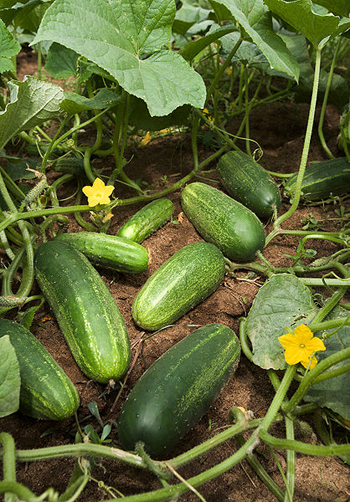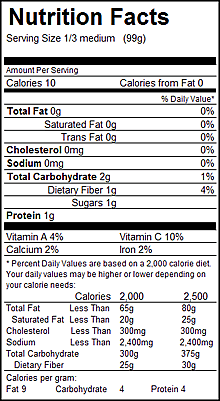Contents:
Common Names | Parts Usually Used | Plant(s) & Culture | Where Found | Medicinal Properties
Legends, Myths and Stories | Uses | Formulas or Dosages | Nutrient Content | How Sold | Bibliography
Scientific Names

- Cucumis sativus L.
- Cucurbitaceae
- Gourd family
Common Names
- Cukes
- Hu-kua
Parts Usually Used
Fruit
Back to Top
Description of Plant(s) and
Culture
The cucumber plant is a fleshy, bristly, creeping or climbing vine that attaches itself to objects by means of tendrils. The leaves are mostly long-petioled, cordate, and incised to make 5 points. The flowers are golden-yellow and bell-shaped. The fruit is well known to everyone.
The word cucumber is used with other herbs: Wild cucumber or balsam apple (Echinocystis lobata); Indian cucumber (Medeola virginiana); Cucumber magnolia (Magnolia acuminata); none of which have anything to do with the garden variety of cucumber.
Back to Top
Where Found
Mostly cultivated.
Back to Top
Medicinal Properties
Aperient, diuretic, astringent, refrigerant, alterative
Back to Top
Legends, Myths and Stories
Since ancient times, the juice of the cucumber has been used as a facial cleanser and as a treatment for skin irritations. Cleopatra herself was reputed to have used cucumber to preserve her beautiful skin.
Chang Chien, the noted legate of the Han Dynasty, seems to have brought cucumber (Hu-kua) from Central Asia to China, as he did other useful plants.
Cucumber juice is used in many skin products.
Wild cucumber (Echinocystis spp.); the seeds were roasted and eaten for kidney troubles by California Native Americans.
When a cucumber is taken from the vine, cut it with a knife leaving about 1/8 of an inch of the cucumber on the stem, then slit the stem with a knife from its end to the vine, leaving a small portion of the cucumber on each division. On each separate split there will be a new cucumber formed as large as the first; thus, making the cucumber vines bear more crops.
According to the old ways, this method of keeping cucumbers is given. For one barrel, use 3 lbs. of alum, 6 qt. of salt and water sufficient to cover them. Finely pulverize the alum and use coarse salt (solar salt, such as used for packing is best, as it contains no lime). Use only 1/4 the quantity to commence on as those put in first will take all the strength of the brine. Keep a weight on them and treat as ordinary salt pickles.
Back to Top
Uses
Cucumber’s ability to eliminate water from the body makes it important for heart and kidney problems. Helps to dissolve uric acid accumulations such as kidney and bladder stones. Cucumber juice helps intestines, lungs, kidneys, and skin. For skin problems and for cosmetic purposes, rub the juice into the skin. Eaten as a vegetable, it is a good diuretic and can help prevent constipation. Apply it also to inflammations, bed sores, scalds and burns. Cucumber is used for cleansing the skin, bleaching (for freckles and discolored skin); also for sunburn, and rough skin. Cucumber slices or juice is applied to the face and/or hands, and left on 10-15 minutes, then rinsed off. Best for normal or oily skin.
Researchers are now investigating an extract of cucumber as a possible “cholesterol buster.”
Back to Top
Formulas or Dosages
The most medicinally effective cucumbers are fully ripe, indicating a beginning yellow color.
Juice: mix with apple, celery, or carrot juice to improve the taste. Take as required. Easily prepared in an electric vegetable juicer.
For bags under the eyes; sometimes caused by water retention, sleep loss, etc. This remedy should be used daily until results are achieved. Grated cucumber may be applied to the area under the eyes for 15 minutes while lying down in a relaxed, comfortable position. This remedy imparts a sense of freshness, and excellent results have been reported. Peeled and grated potato can be used instead of the cucumber if desired.
Lotion: 1/2 pt. juice of cucumber; 1 1/2 oz. deodorized alcohol; 3 1/4 oz. oil of Benne; 1 dram powdered Castile soap; 1 3/4 drams blanched almonds. Work the soap into cucumber juice, beat up almonds in a clean stone mortar and gradually work in cucumber liquid with soap. Strain through a clean muslin strainer, then return to mortar and while stirring gradually work in alcohol in which oil of Benne has been previously dissolved. Use in massaging the face and throat as it not only whitens the skin but also tones relaxed tissues. It may also be used to cleanse the skin.
Juice lotion: cut cucumbers into small pieces, pound them into a paste, then extract the juice by straining through a jelly bag or strainer. Apply to the skin twice or three times a day. Cucumbers may also be used in the raw state by merely dicing them and rubbing the skin briskly with the diced parts.
Complexion wash: a home-made cream for whitening the neck can be made from cucumbers. Cut one cucumber into 1/2 inch slices and place in a double boiler. Pour over the cucumber, 1 oz. almond oil. Allow this mixture to simmer for several hours. Pour off the liquid and measure it. To each oz. of the liquid add just under an oz. of lanolin and less than 1/2 oz. white wax. Warm this mixture together and stir thoroughly. Add some lavender essence before putting into jars.
Back to Top
Nutrient Content
Iron, phosphorus, magnesium

How Sold
In the supermarket produce section.
Back to Top
Bibliography
![]() Culpeper’s Complete Herbal & English Physician: Updated With 117 Modern Herbs
Culpeper’s Complete Herbal & English Physician: Updated With 117 Modern Herbs, by Nicholas Culpeper, Meyerbooks, publisher, PO Box 427, Glenwood, Illinois 60425, 1990, (reprint of 1814)
![]() Chinese Medicinal Herbs
Chinese Medicinal Herbs, compiled by Shih-Chen Li, Georgetown Press, San Francisco, California, 1973.
![]() Eastern/Central Medicinal Plants
Eastern/Central Medicinal Plants, by Steven Foster and James A. Duke., Houghton Mifflin Company, 215 Park Avenue South, New York, NY 10000
![]() The Herbalist Almanac
The Herbalist Almanac, by Clarence Meyer, Meyerbooks, publisher, PO Box 427, Glenwood, Illinois 60425, copyright 1988, fifth printing, 1994
 Earl Mindell’s Herb Bible
Earl Mindell’s Herb Bible, by Earl Mindell, R.Ph., Ph.D., Simon & Schuster/Fireside, Rockefeller Center 1230 Avenue of the Americas, New York, New York 10020
![]() The Herb Book
The Herb Book, by John Lust, Bantam Books, 666 Fifth Avenue, New York, NY. copyright 1974.
![]() Indian Uses of Native Plants
Indian Uses of Native Plants, by Edith Van Allen Murphey, Meyerbooks, publisher, PO Box 427, Glenwood, Illinois 60425, copyright 1958, print 1990
 The Magic of Herbs in Daily Living
The Magic of Herbs in Daily Living, by Richard Lucas, Parker Publishing Co. (1988).
 Old Ways Rediscovered
Old Ways Rediscovered, by Clarence Meyer, Meyerbooks, publisher, PO Box 427, Glenwood, Illinois 60425, published from 1954, print 1988
![]() Planetary Herbology
Planetary Herbology, by Michael Tierra, C.A., N.D., O.M.D., Lotus Press, PO Box 325, Twin Lakes. WI 53181., Copyright 1988, published 1992
![]() Webster’s New World Dictionary
Webster’s New World Dictionary, Third College Edition, Victoria Neufeldt, Editor in Chief, New World Dictionaries: A Division of Simon & Schuster, Inc., 15 Columbus Circle, New York, NY 10023
 The Rodale Herb Book: How to Use, Grow, and Buy Nature’s Miracle Plants (An Organic gardening and farming book)
The Rodale Herb Book: How to Use, Grow, and Buy Nature’s Miracle Plants (An Organic gardening and farming book), edited by William H. Hylton, Rodale Press, Inc. Emmaus, PA, 18049., 1974
